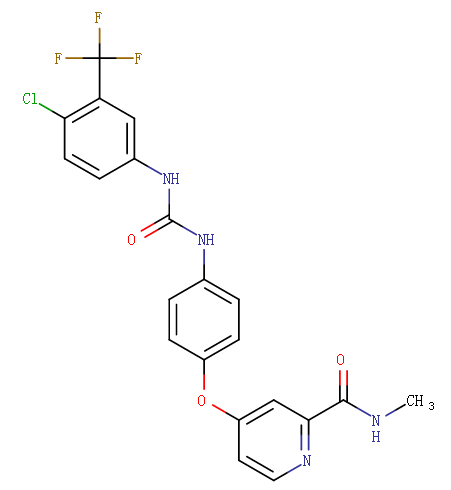Sorafenib
Other name
-
International/Other brands
Nexavar
Groups
Approved
Structure

Prescription products
| Name | Dosage | Strength | Route | Labeller |
|---|---|---|---|---|
| Nexavar | Tablet, film coated | 200 mg/1 | Oral | Bayer |
| Nexavar | Tablet, film coated | 200 mg | Oral | Bayer Pharma Ag |
| Nexavar | Tablet | 200 mg | Oral | Bayer |
Target
Description
Sorafenib (rINN), marketed as Nexavar by Bayer, is a drug approved for the treatment of advanced renal cell carcinoma (primary kidney cancer). It has also received "Fast Track" designation by the FDA for the treatment of advanced hepatocellular carcinoma (primary liver cancer), and has since performed well in Phase III trials. Sorafenib is a small molecular inhibitor of Raf kinase, PDGF (platelet-derived growth factor), VEGF receptor 2 & 3 kinases and c Kit the receptor for Stem cell factor. A growing number of drugs target most of these pathways. The originality of Sorafenib lays in its simultaneous targeting of the Raf/Mek/Erk pathway.
Indications
Advanced Renal Cell Carcinoma, Gastrointestinal Stromal Tumors; Unresectable Hepatocellular Carcinoma; Locally recurrent refractory to radioactive iodine treatment Thyroid carcinoma; Metastatic refractory to radioactive iodine treatment Thyroid carcinoma
Other indications
-
Mechaism of action
-
Absorption
The mean relative bioavailability is 38-49% for the tablet form, when compared to an oral solution. Sorafenib reached peak plasma levels in 3 hours following oral administration. With a high-fat meal, bioavailability is reduced by 29% compared to administration in the fasted state.
Metabolism
Sorafenib is metabolized primarily in the liver, undergoing oxidative metabolism, mediated by CYP3A4, as well as glucuronidation mediated by UGT1A9. Sorafenib accounts for approximately 70-85% of the circulating analytes in plasma at steady- state. Eight metabolites of sorafenib have been identified, of which five have been detected in plasma. The main circulating metabolite of sorafenib in plasma, the pyridine N-oxide, shows in vitro potency similar to that of sorafenib. This metabolite comprises approximately 9-16% of circulating analytes at steady-state.
Toxicity
The highest dose of sorafenib studied clinically is 800 mg twice daily. The adverse reactions observed at this dose were primarily diarrhea and dermatologic events. No information is available on symptoms of acute overdose in animals because of the saturation of absorption in oral acute toxicity studies conducted in animals.